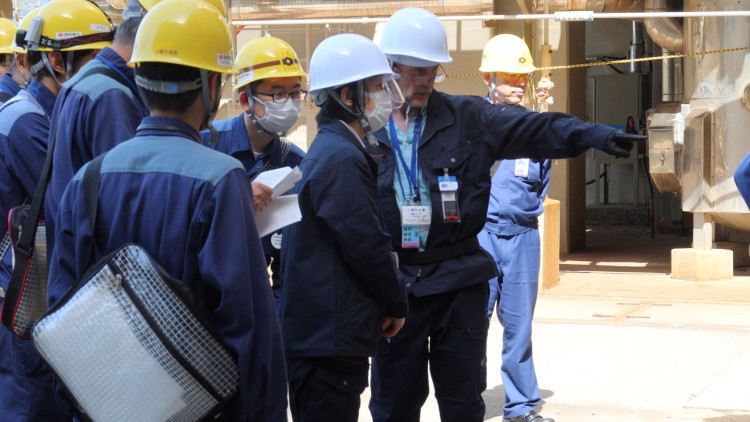An International Atomic Energy Agency (IAEA) team of experts today completed a review of long term operational safety of Unit 3 at the Mihama Nuclear Power Plant (NPP) in Japan.
The SALTO (Safety Aspects of Long Term Operation) review mission from 16 to 25 April was requested by the plant’s operator, Kansai Electric Power Company (KEPCO).
Unit 3 started its commercial operation on 1 December 1976. It underwent an outage of approximately ten years after the Fukushima-Daiichi nuclear power station accident in March 2011. In 2015, KEPCO applied to extend the operational period of Mihama NPP Unit 3 from 40 to 60 years until November 2036. In 2016, Japan’s Nuclear Regulation Authority (NRA) approved the extension. In 2021, Unit 3 of Mihama NPP was restarted and commenced its long term operation.
The SALTO team assessed the strategy and key elements for safe long term operation (LTO) of nuclear power plants based on the IAEA safety standards. During the ten-day mission, the team reviewed the plant’s preparedness, organization, and programmes for safe LTO. The mission was conducted by an 11-person team comprising experts from the Czech Republic, France, Sweden, the United Kingdom, and the United States of America as well as three observers from Finland and the Republic of Korea, and two IAEA staff members. The team had in depth discussions with staff from the Mihama NPP and conducted plant walkdowns during the review.
“The team observed that KEPCO is implementing measures for safe LTO in a timely manner and the staff at the plant are professional, open and receptive to proposals for improvement,” said team leader and IAEA Nuclear Safety Officer Martin Marchena. “Some ageing management and LTO activities already meet IAEA safety standards. We encourage the plant to address the review findings and implement all remaining activities for safe LTO as planned.”
The team identified good performances, including:
- The plant has developed and effectively implemented a comprehensive methodology for identification and management of design obsolescence. The use of this methodology constitutes a powerful tool to proactively address obsolescence issues and identify safety improvements.
- The plant has participated in benchmarking efforts related to ageing management of the steel containment and containment pressure testing and uses these benchmarking efforts to enhance the ageing management activities of the civil structures.
- The plant has put in place an effective mentoring programme using retired staff as mentors for new and current staff to develop their competencies and skills.
The team also provided recommendations and suggestions to further improve safe LTO; the most significant are the following:
- The plant should further develop and implement the LTO programme.
- The plant should fully develop and complete the Ageing Management Review process for mechanical, electrical, and Instrumentation and Control (I&C) components and civil structures.
- The plant should improve the programmes designed to confirm the resistance of components to harsh conditions, a so-called equipment qualification programme.
The plant management expressed a determination to address the areas identified for improvement and to continue its cooperation with the IAEA.
“KEPCO is wholly committed to improving upon the topics recommended and suggested through the SALTO review,” says Kazutaka Tsuru, the General Manager of Mihama Power Station. “As a pioneer in Japan’s nuclear power generation sector, we also intend to roll out the improvements to domestic nuclear power stations and contribute to maintaining and developing the country’s nuclear power generation. Harnessing the knowledge obtained from the review, we hope to make efforts to achieve higher standards with the support of IAEA members. I would like to express my appreciation again for the dedicated support the IAEA team provided for the review.”
The team provided a draft report to the plant management and to the NRA at the end of the mission. The plant management and the NRA will have an opportunity to make factual comments on the draft. A final report will be submitted to the plant management, National Regulatory Authority (NRA) and the Japanese Government after comments are addressed.
Background
SALTO peer reviews are comprehensive safety reviews addressing strategy and key elements for the safe long term operation of nuclear power plants. They complement OSART missions, which are designed as a review of programmes and activities essential to operational safety. Neither SALTO nor OSART reviews are regulatory inspections, nor are they design reviews or substitutes for an exhaustive assessment of a plant's overall safety status.
LTO of nuclear power plants is defined as operation beyond an established time frame determined by the license term, the original plant design, relevant standards, or national regulations. As stated in IAEA safety standards, to maintain a plant’s fitness for service, consideration should be given to life limiting processes and features of systems, structures, and components (SSC), as well as to reasonably practicable safety upgrades to enhance the safety of the plant to a level approaching that of modern plants.
More information on SALTO missions can be found here.


